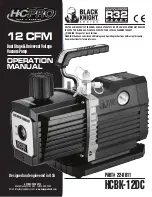
PAGE 18 — QP3TK TRASH PUMP • OPERATION AND PARTS MANUAL — REV. #0 (07/28/17)
7. The discharge side may utilize proper discharge hoses,
PVC pipe, or concrete pipe.
8. Check that discharge hoses lay flat and as straight as
possible. Remove any sharp bends or kinks from the
hose so the water flow cannot be blocked.
9. Once the engine is started; and depending on the
application set-up, the priming process will take a few
moments before water begins to flow.
10. The performance of the pump (Flow, Head, Water
Velocity, and Pressure) is dependent on the many
factors that surround the application. These factors
include, but are not limited to: operating altitude, suction
lift, discharge and suction hose diameter and length,
overall friction loss coefficients, the specific gravity of
the fluid to be pumped, the fluid temperature, and total
discharge head.
CAUTION
The strainer should be positioned so it will remain
completely
under water
. Running the pump with the
strainer above water for long periods can damage the
pump.
1. It is advantageous to place the pump as close as
possible to the water source (Figure 8) on a solid, level
operating surface. The most critical factor for successful
pump operations is not to exceed 25 feet (7.62 meters)
total suction lift (at sea level).
2. Ensure that the pump has the proper level of engine oil.
3. Initially prime the pump by removing the fill cap
(see Figure 3) and filling the casing with water. If the
pump casing is not filled with water prior to operations,
it will not be able to start the pumping process and you
risk overheating the mechanical seal assembly.
4. Attach the proper suction and discharge hoses to the
pump ports. Ensure that the hoses O-rings are in place,
and that hoses do not show any cracks, gouges, or
holes. The hoses should not be kinked, and must be
secured tightly to their respective ports.
5. A proper suction hose is commonly reinforced with rigid
PVC helix and is specifically designed to safeguard
against collapsing during pumping operations. It is
essential that the pump utilize a suction hose with the
same diameter as the suction port.
6. Ensure that the strainer is placed on the end of the
suction hose, and that the hose is placed in the water
source in such a manner as not to bury the strainer
into the sand or silt.
SETUP
Figure 8. Pump Placement
Go
to
Discount-Equipment.com
to
order
your
parts
















































